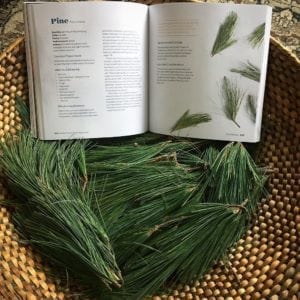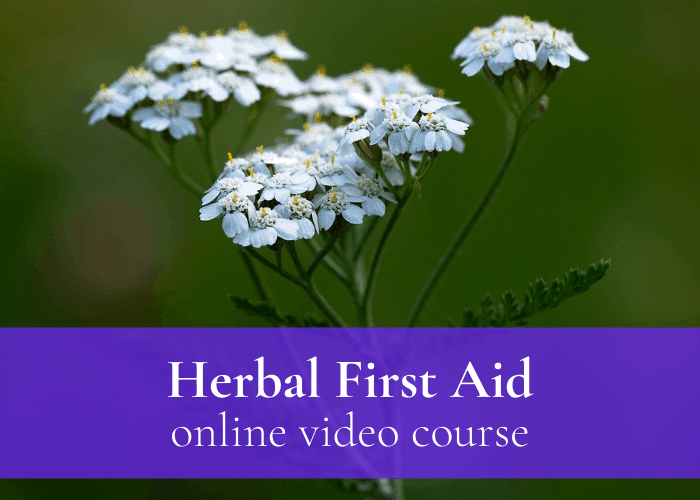White Pine: Herb of the Week
White pine is one of my very favorite herbal teas – it’s so delicious! “Like drinking a Christmas tree” might not sound super appealing, but give it a try sometime. I bet you’ll love it.

A Giving Tree
Not only that, white pine has a lot to offer, starting with its needles. You don’t even have to cut anything off the tree to harvest pine needles – just go for a walk after a storm and collect any fallen branches! You’ll always have a good supply of pine needles. (Lucky, because a mature white pine tree is way too tall to have to go up and cut branches!) It’s a very generous tree.
We don’t dry pine needles because they lose all their “oomph” really quickly, so we only really gather what we can drink up in a week or so. During that time, it’s fine to just leave them in a basket on the counter in your kitchen.
In this post I’ll share some of my favorite things about pine, so read on!

Five-Needled Friend
White pine needles are an excellent source of vitamin C, which was particularly helpful during the long winter months before we could store fruits and vegetables (or ship them from far away places). Pine also has a complex of volatile oils that is super helpful for respiratory health – stimulating heat in the lungs and making life difficult for microbial invaders. Put those things together and you have the perfect cold-and-flu fighting combination!
How do you know that you have white pine? Check the needles. See how they’re in little “bundles” on the branch – groups of needles bound at the connecting point there? If there are five needles in each bundle, and they’re flexible (not too stiff) you’ve got white pine! (And, there are five letters in “white” – easy to remember!)
(No White Pine in your area? Ponderosa Pine, Pinion Pine, even Red and Yellow Pine are also excellent!)

Resilient Resin
It’s not just the needles that have deliciously potent medicinal action – white pine resin is an amazing antiseptic and wound healing agent. And of course, it would be: that’s its function for the tree, too! Remember, plants make their chemicals for their own purposes. We love to prepare it into a salve along with some plantain-and-calendula-infused oil.
You’ll find globs of resin anywhere the tree has been wounded – it kind of looks like bird poop, just in a place a bird couldn’t actually have pooped! When you gather it, be considerate: the resin is the immune system and scab for the tree, so don’t take it all! Make sure you leave a generous amount covering the cut in the bark, and only take the extra globby part on top.
Your fingers will get very, very sticky – bring some olive oil with you to wash the resin off afterwards (it’s highly oil soluble). Don’t worry about bits of dirt, twigs, or even bugs in the resin – that will all come out in the process of making salve. Of course, if you’re hiking and don’t have the time or tools to make salve, just smear some of the sticky resin directly on your clean wound – it will be sticky, but it will help! (Make sure to cover it with a clean bandage or cloth, otherwise that stickiness will attract all kinds of dirt!)

Pine Resin Salve
This is how we harvest pine resin! Teamwork is how to reach the higher spots.
Turning it into salve couldn’t be eaiser – you’ll find complete instructions on page 219 of our new book, Herbal Medicine for Beginners, and close up VIDEO instructions in our Herbal First Aid online course – but here’s the quickie version:
- Get a bunch of pine resin and melt it into olive oil on low heat (we like to use plantain and calendula infused olive oil).
- Strain out any bits of dirt and stuff.
- Add in shaved beeswax, and let that melt slowly.
- Once it cools, presto! The best first aid salve you EVER had!
You can learn to make Pine resin salve, as well as ALL of our strategies for herbal first aid – including everything you need to create your own herbal first aid kits – in our Herbal First Aid video course! There are more than 10 hours of close up videos showing you how to be your own first responder – plus videos about basic pain management, materia medica of all the herbs you’ll work with, and more!
2 Comments
Leave a Comment
You must be logged in to post a comment.

Join our newsletter for more herby goodness!
Get our newsletter delivered right to your inbox. You'll be first to hear about free mini-courses, podcast episodes, and other goodies about holistic herbalism.


[…] discussed include white pine, sage, ground ivy, boneset, elecampane, ginger, catnip–elderflower–chamomile, and […]
[…] discussed include pine, blackberry, yellow dock, goldenseal, Oregon grape, barberry, goldthread, rose, witch hazel, […]